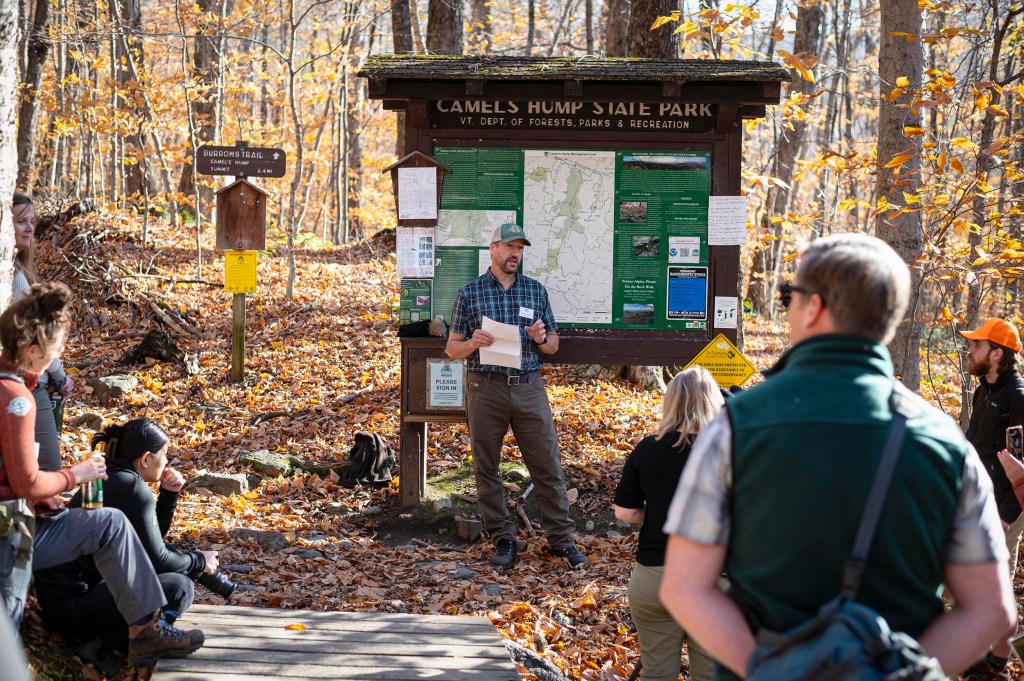Mike DeBonis, executive director of the Green Mountain Club speaks during a tour of a rebuilding project of the Burrows Trail at Camel’s Hump State Park in Huntington on Wednesday, October 23. Photo by Glenn Russell/VTDigger
HUNTINGTON — After three years of seasonal restoration work on the popular Burrows hiking trail on Camel’s Hump, the Green Mountain Club and Vermont Department of Forests, Parks and Recreation have announced its completion.
On Wednesday morning, a group of hikers, including University of Vermont staff and state officials, gathered at the trailhead as yellow and orange leaves swirled through the air. The celebration included speeches from members of the Green Mountain Club and an educational hike along the trail.
“This rehabilitation project is the largest trail project the GMC has undertaken in modern history,” said Mike DeBonis, the executive director of Green Mountain Club, during the event in Huntington. “The Burrows Trail, based on its level of use, which is exceedingly high, and its condition and climate risk, made it the perfect candidate for this kind of large scale investment.”
Kathryn Wrigley of the Vermont Department of Forests, Parks and Recreation speaks during a tour of a rebuilding project of the Burrows Trail at Camel’s Hump State Park in Huntington on Wednesday, October 23. Photo by Glenn Russell/VTDigger
The Burrows Trail, built over 100 years ago, before sustainable trail design principles were developed, is among Vermont’s busiest hiking routes. Its popularity is largely due to its location near Burlington and the relatively short hike it offers to the summit of Camel’s Hump, one of the state’s tallest and most iconic mountains.
“Thinking of this project, two key attributes of success stand out,” DeBonis said. “First, the impact of the state’s financial investment and second is the power of partnerships.”
Planning for the project began in 2018, and work on the 2.1-mile trail started in June 2022, targeting more than 300 areas on the trail that needed improvements. The effort, led by the club and the department, included various partners, such as the Vermont State Trail Crew, Vermont Youth Conservation Corps, Northwoods Stewardship Center, National Civilian Conservation Corps and several volunteer groups.
“It was an amazing opportunity to bring together a bunch of different groups who work in outdoor recreation already on state lands onto one project,” said Kathryn Wrigley, an outdoor recreation specialist at the Department of Forests, Parks and Recreation, during Wednesday’s event.
Keegan Tierney of the Green Mountain Club points to a section of the Burrows Trail, left, that was re-routed, center, during a tour of a rebuilding project at Camel’s Hump State Park in Huntington on Wednesday, October 23. Photo by Glenn Russell/VTDigger
One of the key improvements to the trail included the strategic placement of large branches, tree trunks and natural debris along its edges, a technique referred to as “brush-ins” by the Green Mountain Club. These brush-ins are used to prevent trail-widening and the creation of “social trails,” which are unofficial paths made by hikers seeking shortcuts or bypasses around obstacles or people. These unauthorized trails contribute to the loss of vegetation and increased trail erosion.
The club and the department identified 117 sections along the trail where the path had widened excessively. The trampled areas were more noticeable after the Covid-19 pandemic reached Vermont because people were staying far apart from each other, according to Wrigley.
“So the sticks are intended to keep people off and allow vegetation to start regrowing,” she said.
Keegan Tierney, the Green Mountain Club’s director of field programs, pointed out other harder-to-see changes during Wednesday’s hike: for instance, hardened crossings, which involve fortifying the banks of a stream so it doesn’t become a mud pit.
Keegan Tierney of the Green Mountain Club explains how two thirds of a rock used in a waterbar is underground during a tour of a rebuilding project at Camel’s Hump State Park in Huntington on Wednesday, October 23. Photo by Glenn Russell/VTDigger
The club also installed 150 waterbars to reduce trail erosion. The structures are designed to channel water off the trail, helping to prevent further damage caused by water runoff.
The project, which cost nearly $700,000, was funded through a combination of sources, including a one-time allocation of state general funds for outdoor recreation improvements; the department’s Enhancement of Recreation Stewardship and Access Grant, and private donations to the club.
The cost of the project was impacted by the lack of access to mechanized equipment. Tierney said all of the work had to be done manually, pointing at the rocks to create the treadway.
“It’s labor intensive,” said Tierney. “It’s probably two weeks of brute time right here.”
Both Wrigley and Tierney emphasized the magnitude of the partnerships. The club has recently started to train its 250 volunteers to recognize trail structures and clean them to keep trails open in the long run.
“We’re investing the time in those folks so they can go out and be like ‘oh I see this, I need to clean it’,” said Tierney. “That’s a huge investment on their part as volunteers. They’re given their time and money to get here.”
Read the story on VTDigger here: Green Mountain Club celebrates rehabilitation of a popular Camel’s Hump trail.

